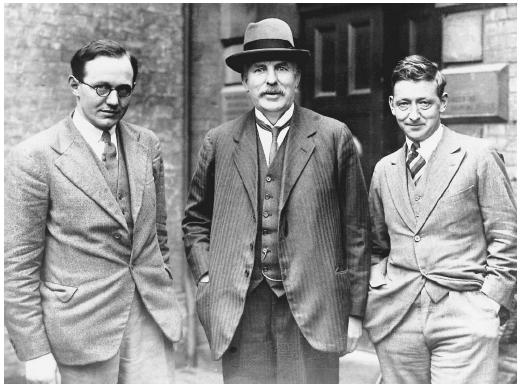Ernest Rutherford
BRITISH PHYSICIST
1871–1937
Ernest Rutherford was born on August 30, 1871, near Nelson, New Zealand. He was a very good student, excelling at science and mathematics. In 1889 Rutherford won a scholarship to study at Canterbury College, Christchurch, New Zealand, and it was at college that he began his work as a scientist. He conducted experiments on the speed of induction in iron placed in rapidly alternating magnetic fields. In 1894, in part because of his original work, he was awarded a scholarship to study at Trinity College, Cambridge, with famed physicist J. J. Thomson. At first he continued his research on magnetism, but by 1896 Rutherford and Thomson were working together on the conductivity of electricity in gases using x rays.
Rutherford's skill and experience in conceiving and building delicate experimental apparatus were crucial to another project that would prove to be

his most important contribution to science. Following his research on x rays, Rutherford began to study the effect of radiation from uranium on the conductivity of gases. During this work, he determined that there were two kinds of radiation, which he called α and β rays. These could be distinguished by their ability to penetrate materials: α rays would not pass through a thin piece of paper; β radiation was more powerful and could penetrate thin sheets of metal foil.
In 1903, with the scientist Frederick Soddy, Rutherford concluded that radiation was caused by atoms of radioactive material breaking apart. The tiny bits that broke off were the α and β rays. This was a revolutionary idea, since it had been a basic principle of physics and chemistry that atoms were the smallest possible particles of matter and therefore indivisible. Rutherford went on to demonstrate that α -particles were, in fact, a form of the helium atom. He did this by placing a delicate glass bulb containing radon gas, which emitted α -particles, in an evacuated tube. The particles would penetrate the glass of the bulb but not escape the tube, and could then be analyzed.
As part of these studies, Rutherford and his assistant Hans Geiger created an α -particle detector (known today as the Geiger counter) in 1908. In 1909 Rutherford gave his student Ernest Marsden the task of studying whether metal would deflect the path of an α -particle. This was the wellknown gold foil experiment, in which it was observed that one particle in about 8,000 bounced off a thin foil of gold rather than passing through it. This surprised everyone, and as Rutherford stated, "It was about as credible as if you had fired a 15-inch shell at a piece of tissue paper and it came back and hit you" (Glasstone, p. 93). Rutherford showed that the collision had to occur with something that was small and very massive (compared to the α -particle) and that carried an electrical charge.
These experiments led to Rutherford's 1911 hypothesis that the atom consisted of a hard core (named the nucleus in 1912) that contained almost all the mass of the atom and had a positive charge, and that the electrons, which had little mass and a negative charge, orbited the core at a distance. Rutherford's work transformed the concept of the atom from that of a solid body into one of mostly empty space. Although the new model explained the experimental results, it was not compatible with classical physics. If the electrons orbited the nucleus like planets orbit the Sun, they would slow down and collapse into the center. In 1912 the Danish physicist Niels Bohr arrived in England to work with Rutherford, and he applied the quantum theory of the German physicist Max Planck to the model. According to this theory, electrons could only gain or lose energy in fixed amounts called quanta . So long as an electron did not change its orbit, it would never collapse into the nucleus. Although there have been further refinements to the Bohr-Rutherford model of the atom—for example, electrons do not actually orbit—it is an important model of atomic structure.
Rutherford won many awards for his work as a scientist and teacher. He won the Nobel Prize for chemistry in 1908 and was knighted in 1914. In 1919 he became the Cavendish Professor of Physics at Cambridge. He was made Lord Rutherford of Nelson in 1931. Rutherford died at Cambridge on October 19, 1937.
SEE ALSO Bohr, Niels ; Marsden, Ernest ; Soddy, Frederick ; Thomson, Joseph John .
Andrew Ede
Bibliography
Glasstone, Samuel (1958). Sourcebook on Atomic Energy, 2nd edition. Princeton, NJ: Van Nostrand.
Heilbron, John L. (2003). Ernest Rutherford and the Explosion of Atoms. New York: Oxford University Press.
Rutherford, Ernest (1937). The Newer Alchemy: Based on the Henry Sidgwick Memorial Lecture Delivered at Newnham College, Cambridge, November, 1936. New York: Macmillan.
Internet Resources
"Ernest Rutherford—Biography." Nobel e-Museum. Available from http://www.nobel.se/chemistry/laureates/1908/rutherford-bio.htm. .
Comment about this article, ask questions, or add new information about this topic: